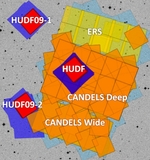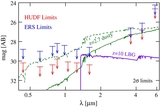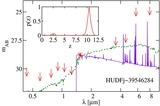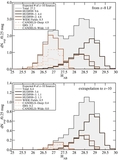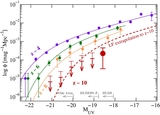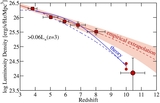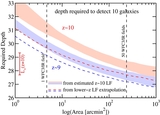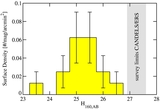Image Details
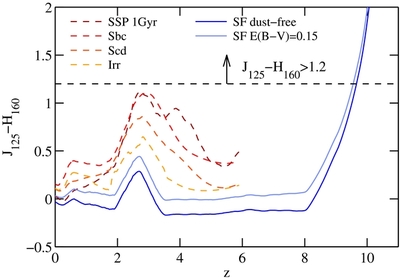
Caption: Figure 2.
Color selection of
z > 9.5 galaxies (Section 3.2). Shown are the
J
125 −
H
160 colors of different types of galaxies as a function of their redshift. Star-forming galaxies are shown as solid blue lines.
The lighter blue spectral energy distribution (SED) is reddened by
E(
B −
V) =0.15 mag using a Calzetti et al. (2000) dust law. As the Lyα absorption due to intergalactic neutral hydrogen shifts into
the
J
125 band, galaxies start to exhibit progressively redder colors beyond
z ~ 8. A selection with
J
125 −
H
160 > 1.2 thus identifies galaxies at
z
![]() 9.5. Strong Balmer and 4000 Å breaks in evolved
z ~ 3 galaxies, combined with some dust obscuration can also result in very red
J
125 −
H
160 colors. The dashed lines correspond to more evolved galaxies dominated by progressively older stellar populations from the
library of Coleman et al. (1980) as well as a 1 Gyr old single stellar population (SSP) from the library of Bruzual & Charlot
(2003).
Spitzer IRAC data provide a way to separate these different populations at intermediate and very high redshifts (see the text and
Figure
3).
9.5. Strong Balmer and 4000 Å breaks in evolved
z ~ 3 galaxies, combined with some dust obscuration can also result in very red
J
125 −
H
160 colors. The dashed lines correspond to more evolved galaxies dominated by progressively older stellar populations from the
library of Coleman et al. (1980) as well as a 1 Gyr old single stellar population (SSP) from the library of Bruzual & Charlot
(2003).
Spitzer IRAC data provide a way to separate these different populations at intermediate and very high redshifts (see the text and
Figure
3).
Copyright and Terms & Conditions
© 2012. The American Astronomical Society. All rights reserved.


